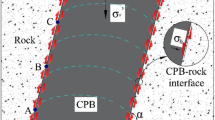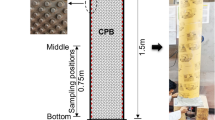Abstract
Determination of interface shear behaviour is critical for the design of many geotechnical structures, including cemented paste backfill structures. However, the shear characteristics of the CPB–rock interface is not fully understood. No studies have been conducted to assess the impact of the characteristics of rock (e.g., type of rock, rock surface roughness), cementation and the coupled effects of surface roughness and degree of cementation on the shear characteristics of the interface between rock and tailings backfill. This paper presents new findings of research conducted to investigate the effect of different types of rock, rock surface roughness and degree of cementation as well as the coupled effects of these factors on the shear properties and behaviour of the interface between cemented paste backfill (CPB) and rock. The results show that roughness and the interaction between roughness and degree of cement hydration have a significant effect on the shear characteristics of a CPB–rock interface. For a certain degree of cementation, the roughness can increase the shear strength due to the increased size of the interlocking structure. The interface samples with roughness, especially those sheared at high normal stress, tend to experience two peak shear stresses during the shear test. Moreover, the shear strength, shear dilation, and adhesion of the interface also increase with degree of cementation. However, according to the revised Barton’s equation, the effective friction angle of interface with roughness experiences a decreasing tendency with degree of cementation, despite the increasing tendency of the friction angle of the smooth interface. In other words, the interface asperity contributes more to the evolution of adhesion, and the contribution of friction angle to the shear strength is partially offset. It is also found that the rock type (considered in this study) has limited effects on the interface shear properties. The failure of the interface between CPB and rock is because of the existence of the interfacial transition zone, which is characterized by high porosity. These new findings have practical importance to the design of the underground CPB structures.


Adapted from Cui and Fall (2017)















Similar content being viewed by others
References
Bahaaddini M, Hagan PC, Mitra R, Hebblewhite BK (2015) Parametric study of smooth joint parameters on the shear behaviour of rock joints. Rock Mech Rock Eng 48:923–940
Barton N (1973) Review of a new shear strength criterion for rock joints. Eng Geol 7(4):287–332
Barton N, Choubey V (1977) The shear strength of rock joints in theory and practice. Rock mechanics 10(1):1–54
Brackebusch FW (1994) Basics of paste backfill systems. Min Eng 46:1175–1178
Breton D, Carles-Gibergues A, Ballivy G, Grandet J (1993) Contribution to the formation mechanism of the transition zone between rock-cement paste. Cem Concr Res 23(2):335–346
Brown ET (1981) Rock characterization testing and monitoring (ISRM suggested methods). Pergamon, Oxford
Cao S, Yilmaz E, Xue G, Song W (2019) Assessment of acoustic emission and triaxial mechanical properties of rock-cemented tailings matrix composites. Adv Mater Sci Engg, Article 6742392:12p. https://doi.org/10.1155/2019/6742392
Chen X, Zhang J, Xiao Y, Li J (2015) Effect of roughness on shear behaviour of red clay—concrete interface in large-scale direct shear tests. Can Geotech J 52:1122–1135
Cui L, Fall M (2016a) An evolutive elasto-plastic model for cemented paste backfill. Comput Geotech 71:19–29
Cui L, Fall M (2016b) Mechanical and thermal properties of cemented tailings materials at early ages: influence of initial temperature, curing stress and drainage conditions. Constr Build Mater 125:553–563
Cui L, Fall M (2017) Multiphysics modeling of arching effects in fill mass. Comput Geotech 83:114–131
Diamond S, Huang J (2001) The ITZ in concrete–a different view based on image analysis and SEM observations. Cem Concr Compos 23(2–3):179–188
Dong W, Yang D, Zhou X, Kastiukas G, Zhang B (2017) Experimental and numerical investigations on fracture process zone of rock–concrete interface. Fatigue Fract Eng M 40(5):820–835
EI-Soudani SM (1978) Profilometric analysis of fractures. Metallogr 11:247–336
Fall M, Benzaazoua M (2003) Advances in predicting performance properties and cost of paste backfill. Int. Conf. Tailings Mine Waste, Colorado, USA, pp 12–15
Fall M, Benzaazoua M (2005) Modeling the effect of sulphate on strength development of paste backfill and binder mixture optimization. Cem Concr Res 35(2):301–314
Fall M, Nasir O (2010) Mechanical behaviour of the interface between cemented tailings backfill and retaining structures under shear loads. Geotech Geo Eng 28:779–790
Fall M, Célestin JC, Han FS (2009) Suitability of bentonite-paste tailings mixtures as engineering barrier material for mine waste containment facilities. Miner Eng 22(9–10):840–848
Fall M, Célestin JC, Pokharel M, Touré M (2010) A contribution to understanding the effects of temperature on the mechanical properties of cemented mine backfill. Eng Geol 14(3–4):397–413
Fang K, Fall M (2018) Effects of curing temperature on the shear behaviour of cemented paste backfill–rock interface. Int J Rock Mech Min 112:184–192
Fang K, Fall M (2019a) Chemically induced changes in the shear behaviour of the interface between rock and tailings backfill undergoing cementation. Rock Mech Rock Eng 52:3047–3062
Fang K, Fall M (2019b) Effect of curing stress, drainage condition and filling rate on shear behaviour of the interface between cemented paste backfill and rock. Rock Mech Rock Eng 53:325–336
Gani MSJ (1997) Cement and concrete. Chapman & Hall, London
Ghirian A, Fall M (2013) Coupled thermo-hydro-mechanical-chemical behaviour of cemented paste backfill in column experiments. Part I: physical, hydraulic and thermal processes and characteristics. Eng Geol 164:195–207
Ghirian A, Fall M (2014) Coupled thermo-hydro-mechanical-chemical behaviour of cemented paste backfill in column experiments. Part II: mechanical, chemical and microstructural processes and characteristics. Eng Geol 170:11–23
Grice T (2001) Recent mine developments in Australia. Proceedings of the 7th international symposium on mining with backfill (MINEFILL), p 351–357
Haruna S, Fall M (2020) Time-and temperature-dependent rheological properties of cemented paste backfill that contains superplasticizer. Powder Technol 360:731–740
Han F, Ganju E, Salgado R, Prezzi M (2018) Effects of interface roughness, particle geometry, and gradation on the sand–steel interface friction angle. J Geotech Geoenviron 144(12):04018096
Hassani F, Archibald J (1998) Mine backfill. Canadian Institute of Mine, Metallurgy and Petroleum, Canada
He Y, Zhang X, Hooton R, Zhang X (2017) Effects of interface roughness and interface adhesion on new-to-old concrete bonding. Constr Build Mater 151:582–590
Helinski M, Fahey M, Fourie A (2010) Behavior of cemented paste backfill in two mine stopes: measurements and modeling. J Geotech Geoenviron 137(2):171–182
Jiang HQ, Fall M, Cui L (2016) Yield stress of cemented paste backfill in sub-zero environments: experimental results. Miner Eng 92:141–150
Jiang H, Fall M, Cui L (2017) Freezing behaviour of cemented paste backfill material in column experiments. Construct Build Mater 147:837–846
Ke Y, Ortola S, Beaucour A, Dumontet H (2010) Identification of microstructural characteristics in lightweight aggregate concretes by micromechanical modelling including the interfacial transition zone (ITZ). Cem Concr Res 40(11):1590–1600
Koupouli NJF, Belem T, Rivard P, Effenguet H (2016) Direct shear tests on cemented paste backfill–rock wall and cemented paste backfill–backfill interfaces. J Rock Mech Geotech Eng 8(4):472–479
Kuganathan K (2005) Geomechanics of mine fill. In: Potvin Y, Thomas E, Fourie A (eds) Handbook on mine fill. Australian centre of Geomechanics, Australia, pp 23–49
Li W, Fall M (2016) Sulphate effect on the early age strength and self-desiccation of cemented paste backfill. Constr Build Mater 106:296–304
Maerz NH, Franklin JA, Bennett CP (1990) Joint roughness measurement using shadow profilometry. Int J Rock Mech Min Sci Geomech Abstr 27(5):329–343
Manaras E, De-Souza, Archibald JF (2011). Strength behaviour and failure mechanisms of backfill–rock mass interfaces. Paper presented at the 10th international conference on mining with backfill, The southern African Institute of Mining and Metallurgy, Cape Town, South Africa, 2011
Nasir O, Fall M (2008) Shear behaviour of cemented pastefill–rock interfaces. Eng Geol 101(3):146–153
Nonnet E, Lequeux N, Boch P (1999) Elastic properties of high alumina cement castables from room temperature to 1600 °C. J Eur Ceram Soc 19(8):1575–1583
Orejarena L, Fall M (2011) Artificial neural network based modeling of the coupled effect of sulphate and temperature on the strength of cemented paste backfill. Can J of Civil Eng 38(1):100–109
Pirapakaran K, Sivakugan N (2007) Arching within hydraulic fill stopes. Geotech Geol Eng 25:25–35
Pokharel M, Fall M (2013) Combined influence of sulphate and temperature on the saturated hydraulic conductivity of hardened cemented paste backfill. Cem Concr Compos 8:21–28
Roshani A, Fall M, Kennedy K (2017) A column study of the hydro-mechanical behavior of mature fine tailings under atmospheric drying. Intern J Min Sc Technol 27(2):203–209
Saiang D, Malmgren L, Nordlund E (2005) Laboratory tests on shotcrete–rock joints in direct shear, tension and compression. Rock Mech Rock Eng 38(4):275–297
Scrivener KL, Crumbie AK, Laugesen P (2004) The interfacial transition zone (ITZ) between cement paste and aggregate in concrete. Interface Sci 12(4):411–421
Seidel JP, Haberfield CM (2002) Theoretical models for concrete–rock joints subjected to constant normal stiffness direct shear. Int J Rock Mech Min Sci 39:539–553
Sha W, O’Neill E, Guo Z (1999) Differential scanning calorimetry study of ordinary Portland cement. Cem Concr Res 29(9):1487–1489
Taylor HFW (1964) The chemistry of cements, vol 1. Academic Press, London
Terzaghi K (1943) Theoretical soil mechanics. John Wiley & Sons, New York
Tse R, Cruden DM (1979) Estimating joint roughness coefficients. Int J Rock Mech Min Sci 16(5):303–307
Wang JA, Wang YX, Gao QJ (2015) Behavior of microcontacts in rock joints under direct shear creep loading. Int J Rock Mech Min Sci 78:217–229
Wang Y, Fall M, Wu A (2016) Initial temperature-dependence of strength development and self-desiccation in cemented paste backfill that contains sodium silicate. Cement Concr Compos 67:101–110
Yang PY, Li L (2015) Investigation of the short-term stress distribution in stopes and drifts backfilled with cemented paste backfill. Int J Min Sci Tech 25:721–728
Yang ZY, Lo SC, Di CC (2001) Reassessing the joint roughness coefficient (JRC) estimation using Z2. Rock Mech Rock Eng 34:243–251
Yilmaz E (2018) Stope depth effect on field behaviour and performance of cemented paste backfills. Int J Min Reclam Environ 32(4):273–296
Yilmaz E, Kesimal A, Ercikdi B (2003) The factors affecting the strength and stability of paste backfill. Yerbilimleri–Turkish Earth Sci 28(2):155–169
Yu XB, Vayssade B (1991) Joint profiles and their roughness parameters. Int J Rock Mech Min Sci Geo Mech Abstr 28:333–336
Xue G, Yilmaz E, Song W, Cao S (2019a) Mechanical, flexural and microstructural properties of cement-tailings matrix composites: effects of fiber type and dosage. Compos B Eng 172:131–142
Xue G, Yilmaz E, Song W, Yilmaz E (2019b) Influence of fiber reinforcement on mechanical behavior and microstructural properties of cemented tailings backfill. Constr Build Mater 213:275–285
Zhou Q, Glasser F (2001) Thermal stability and decomposition mechanisms of ettringite at <120 °C. Cem Concr Res 31(9):1333–1339
Acknowledgements
The University of Ottawa, the Natural Sciences and Engineering Research Council of Canada (NSERC), and the China Scholarship Council (CSC) are acknowledged by the authors for their support. Also, the authors want to thank Mr. Glenn for his help on the SEM analysis.
Author information
Authors and Affiliations
Corresponding author
Additional information
Publisher's Note
Springer Nature remains neutral with regard to jurisdictional claims in published maps and institutional affiliations.
Rights and permissions
About this article
Cite this article
Fang, K., Fall, M. Shear Behaviour of Rock–Tailings Backfill Interface: Effect of Cementation, Rock Type, and Rock Surface Roughness. Geotech Geol Eng 39, 1753–1770 (2021). https://doi.org/10.1007/s10706-020-01586-x
Received:
Accepted:
Published:
Issue Date:
DOI: https://doi.org/10.1007/s10706-020-01586-x




